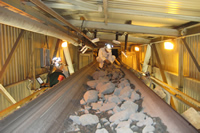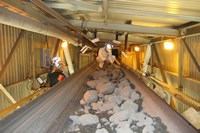 An innovative material tracking system being piloted at Vale Inco’s Frood-Stobie Complex in Sudbury could keep millions of dollars worth of nickel and other metals from being disposed of in tailings.
An innovative material tracking system being piloted at Vale Inco’s Frood-Stobie Complex in Sudbury could keep millions of dollars worth of nickel and other metals from being disposed of in tailings.
Once fully implemented, the tracking system will provide technicians at the company’s Strathcona Mill with ore grade information for material in transit, allowing them to schedule deliveries, blend material from different sources, optimize the mill process and increase recoveries.
The tracking system employs RFID technology and software from Montreal-based Ship2Save Inc. to track ore from the muckpile underground to rail car loading facilities on surface.
Ore tracking will “optimize the milling process because the mill runs different strengths of reagents and adjusts the holding times in the tanks, depending on the grade,” explained senior geological technologist Mark Palkovits.
“If we’re sending a nice flat line grade to the mill, all of the reagents work well and the floatation time is right. If all of a sudden, you send through a big slug of high-grade copper or nickel, and you don’t have enough reagents to float the material, or you don’t have enough time in the tanks, you’re just kicking stuff out to the tailings and losing millions of dollars.”
The process begins at the face, where a geologist tosses three or four specially designed ultra high frequency, passive RFID tags into a muckpile. The geologist associates each tag with the ore grade and location, enters the data into a handheld computer and uploads it on surface to a central database.
The tags are scooped up along with the muck, dumped into an ore pass and introduced into a crusher before being skipped to surface. Though built to take abuse, some of the tags get chewed up along the way.
“That’s why they throw in more than one,” said Ship2Save RFID Solution Architect Eddie Ng.
Challenge
Designing the RFID tags to pass through a crusher and survive the punishing underground environment was the biggest challenge faced by Ship2Save in adapting its technology for the mining industry. The tags are 3 x 5 inches in size, flat and enclosed in a durable plastic casing.
If Vale Inco is satisfied that enough of tags are making it to surface and successfully transmitting data, the next step would be to tag the rail cars and, ultimately, expand the system to other mines, said Palkovits.
Data captured from RFID readers on conveyor belts at loading facilities could then be correlated with tags on the railcars to provide mill operators with precise information on ore grades for every car.
The system can also be used to provide more precise tracking of ore volumes shipped to the mill.
“Last month, for example, we know we shipped around 300,000 tonnes, but 30,000 tonnes was missing,” said Palkovits.
Frood-Stobie loads between 12,000 to 16,000 railcars per month and every single one is recorded by hand, so it’s a tedious job, and some are missed, he explained.
“We didn’t lose the material. The mill got it. They just forgot to write it down. Each railcar holds 80,000 tonnes, so that’s quite a few railcars that somebody didn’t track. We had to spend two days resolving the issue.”
With RFID tagging, the railcars would be tracked automatically.
Time to surface
The system will also help mine personnel track how long it takes for ore to make it to the surface loading facilities.
“We have always estimated that it took 40 days to make it through, but I had one come through in 14 days, so we’re sending a certain grade to the mill and giving it a lag time of 40 days, but now we see that’s not quite right,” said Palkovits. “If we had a bunch of high grade going through, it could come through quickly and then you get lower grade again, so the material is flowing differently than we assumed.”
Some tags will also be introduced into waste rock, sumps and slag used on the roadbeds to keep track of material other than ore that sometimes ends up in the ore stream. While the tracking system does a bit of policing, the main goal is ore blending and mill optimization, said Palkovits.
The pilot got under way in December, and is to be evaluated this spring to determine next steps.



